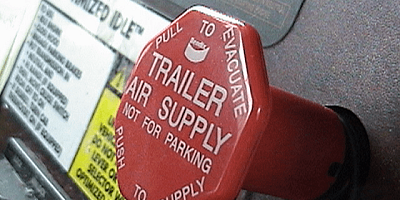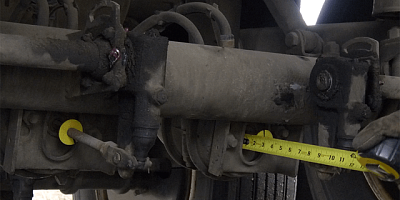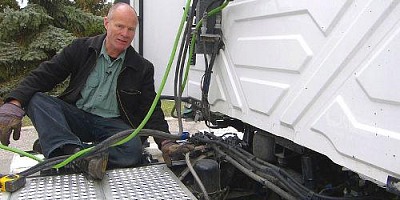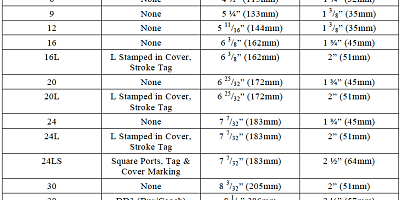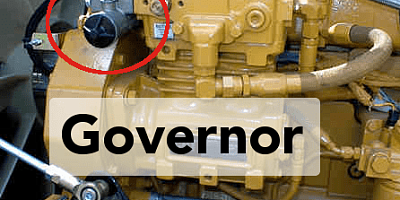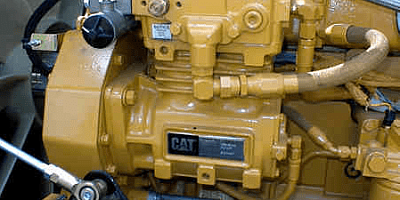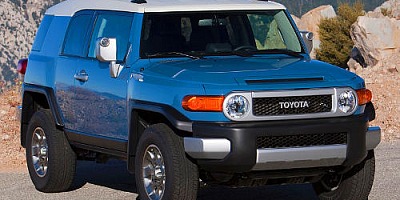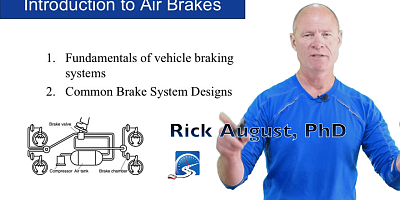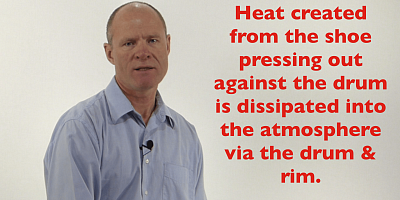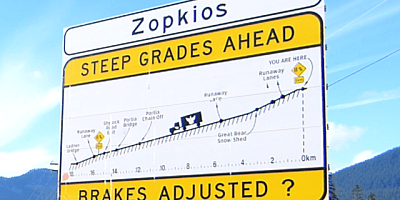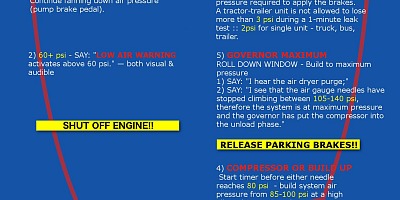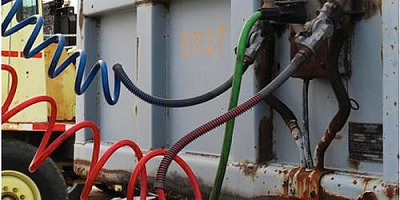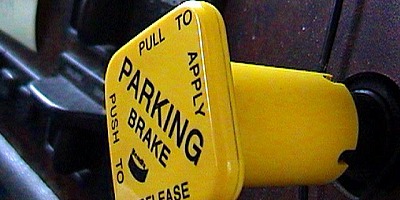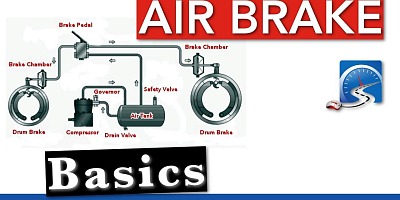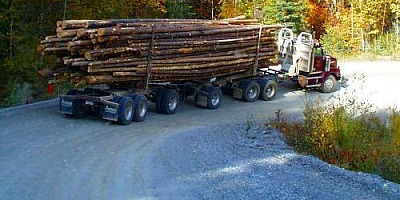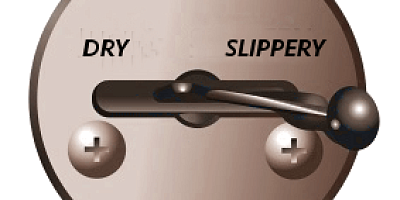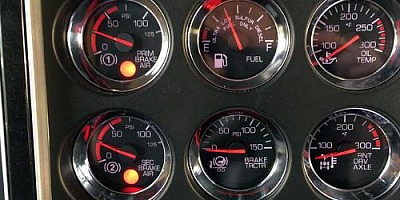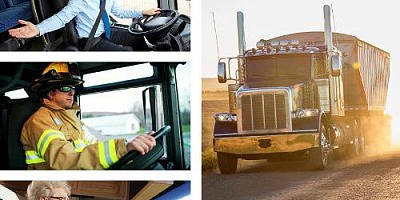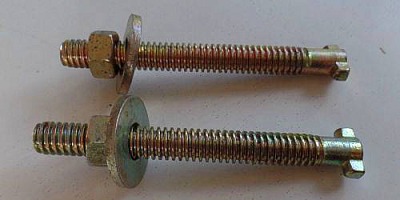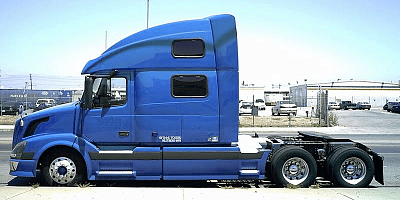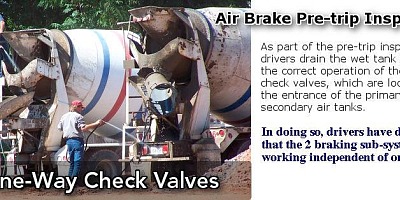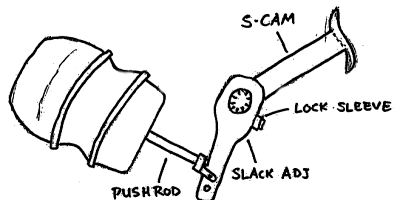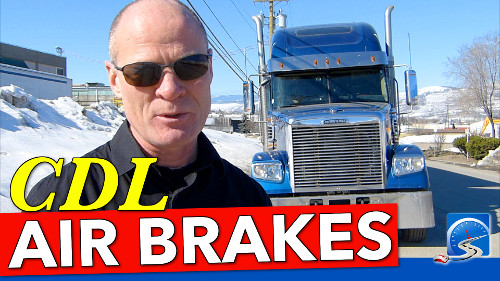Getting your CDL? Learn about air brakes in the state of New York here!
CDL Air Brakes Section 5.2 and 5.3 | New York State
Closed Caption
Introduction
Hi there smart drivers. Rick with Smart Drive Test talking to you today about part two of the three part series on air brakes in the state of New York. We're in the commercial driver's manual section 5.2 and 5.3 which talks about dual air brake systems: the primary and secondary system. If one system fails, the other system will continue to work normally. The two-way check valve will keep the spring brakes off at the back so you don't come to a screeching halt and do a bug impression on the windshield.
Don't Work the Day for Free:: DOT Weigh Scale Checklist |
||
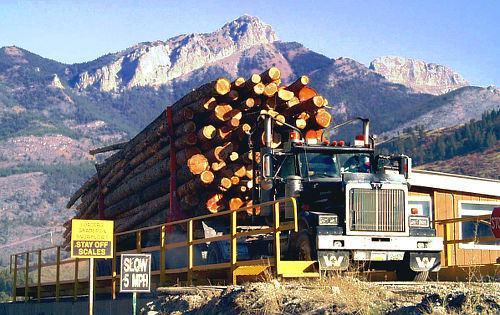
• DID YOU KNOW? :: Bus & truck drivers are the only drivers that have their own police force (DOT, CVSE, MTO, etc.);• SMART :: There's a lot of paperwork you must produce for authorities at the weigh scale;• SELF-CONFIDENCE :: Bring all paperwork in one hit & impress the diesel bears! |
||
Because in most cases, it's you that gets the fine...NOT the company! |
And then we're going to talk about pre-trip inspections: outside of the vehicle - the components that you test - what you say: "secure on the vehicle, not damaged—a rock didn't fly up and hit it— not leaking." 75% of the components on your commercial vehicle have either fluid or air in them. So we're always listening for air leaks because the first part of your pre-trip inspection is to chock the wheels and release the spring brakes. So there is air in the system. So while you're doing your pre-trip inspections around the vehicle, always listening for air leaks. As well you're in-cab checks - your five in-cab checks that you're going to do for the purposes of checking the system to ensure that it's working. The hardest part is the in-cab because it's pure memorization.
You have to check the governor - the minimum & maximum setting, you have to check the low air warning to ensure that it's working at 60 psi or above. Pump down to make sure the spring brakes activate automatically between 20 and 45 psi. And in the state of New York you don't have to go out and check that the spring brakes actually apply. You just have to make sure that the two buttons— the trailer air supply and the parking control valve on the dash pop out between 20 and 45 psi. Then you're going to do a build-up, which is the compressor test.
That the compressor builds air between 85 and a hundred psi in 45 seconds. Most modern air brake systems have more than enough air coming out of the air compressor that they're going to do this well with in that amount of time. Then you're going to pump to maximum pressure. The air dryer purges & the needle stop climbing at maximum pressure because you stopped putting air in the system. That is maximum pressure of the governor and then you're going to do a leak test and check the integrity of the system. Those are the checks. Then at the end, we'll go over the sample test questions that are in the commercial driver's manual. And we're going to talk to you about all of that and give you some more detail about that. So we'll be right back to talk to you about - the commercial driver's manual, section 5.2 & 5.3.
Section 5.2 - Dual Air Brake Systems
Chapter five, section 2 of the air brakes for the New York State CDL exam. Air brakes: dual air brake systems. All braking systems on all modern vehicles are divided into two secondary and primary systems. This is so that if one system fails, the other will continue to work normally. If you open the hood and take the cover off the master cylinder in your car or light truck, you'll see that there's two chambers in there. One is for braking the front axles and the others for braking the rear axles. Air brake systems are the same.
They're divided into a primary and a secondary braking system. If one fails the other will continue to operate normally. The secondary system operates everything in front of the driver and the primary system operates everything behind the driver. Secondary and primary - there are two needles or two gauges to tell you the service pressure in the system. One needle tells you the air pressure in the secondary system, the other tells you the air pressure in the primary system. As I said, if one system fails, the other will continue to operate normally.
One-Way Check Valves
What is primarily responsible for dividing the system into a primary and secondary system is the one-way check valves at the entrance to the primary and secondary air tanks. These stop the air from coming back through if there's a leak in one or the other systems.
Two-Way Check Valves
The other thing is is that there's a two-way check valve between the two tanks. The two-way check valve will direct air to the spring brakes in the event of a catastrophic air loss, from the system that has the highest pressure. Therefore if one system loses air pressure, the other system—the higher pressure—the two- way check valve between the two tanks will direct air to the spring brakes. And the spring brakes will not come on automatically; therefore, you will be able to bring the vehicle to a safe stop and get it off the highway and determine the cause of the air loss is in either one of those two systems.
So the dual air brake system allows the system to operate safely. The system will operate normally as long as the air compressor is working and does not fail.
Section 5.3.1 - Inspecting Engine Compartment Components
Quick overview of pre-trip inspection outside of the vehicle. You have to go outside of the vehicle, & inspect the air brake components. For the purposes of an air brake pre-trip inspection you only need to test the air brake components.
You need to test the compressor that it's bolted securely to the side of the truck. It's not damaged, it's not leaking because it does have oil in it from the lubricating system inside of the motor, securely fastened. If it is belt driven—nineteen seventies—check the condition of the belt. Check the belt for tightness as well. Lines to the brake chambers. Brake chamber secure, not damaged, not leaking.
5.3.2 – During Step 5 Walk-Around Inspection
And in New York state, from the manual you want to do a pry bar test. It says you can pull it with your hand, but you're not going to be able to pull it with your hand and get a determination of whether it's in adjustment or not. So you're going to need a pry bar. Put the pry bar in the slack adjuster at the clevis pin, pull on it and it shouldn't move more than approximately one inch according to New York rules. If it moves more than an inch, it needs to be adjusted.
Now slack adjusters... slack adjusters on an air brake equipped vehicles... as the brakes wear, you need to push out farther and farther on the push rod that comes out of the brake chamber to apply the brakes. To adjust for this wear and clearance, you have a slack adjuster & the slack adjuster takes up the slack in the system. Since 1991 in the United States, all slack adjusters have to be automatic and it's unlikely you're going to find any vehicle except maybe a training vehicle that has manual slack adjusters on it - they're all going to be automatic.
Adjusting an Automatic Slack Adjuster - 6-Pack Adjustment
If the slack adjuster comes out more than an inch there's only one thing you can do to bring it back into adjustment and that's to do a six pack.Six pack with the vehicle equipped with automatic slack adjusters: get in the vehicle, pump it up to full pressure. You know it's at full pressure because the air dryer will purge and the needles will stop climbing between a hundred a hundred thirty-five pounds per square inch. Once you have full pressure, make three hard, hard brake applications - so right down— over a hundred pounds of pressure— release it, make another one over a hundred pounds— three.
At three brake application, you're gonna have to pump it back up again. And then make three more. Often times automatic slack adjusters get out of adjustment and there isn't just enough air brake pressure to cause the ratchet mechanism inside the slack adjuster to click over to the next one, so you've got to do what's called a six pack and that's basically just pumping the system up to maximum pressure making six hard brake applications. You can only make three before you have to bring the pressure back up again because most systems just don't have enough air pressure to do that. That's the only thing you can do.
Adjusting an automatic slack adjuster should only be done in absolute emergencies.
So pry bar method - more than an inch, inspect the components. If there isn't a dust cover inside the wheel and the rim, you want to inspect the lining, the hub. Make sure nothing's cracked, nothing's broken, nothing's hanging off and nothing is leaking, in terms of your pre-trip inspection. So when you go around the vehicle for the purpose of your CDL exam, you have to test the slack adjustment on all the brakes. So if you're doing a tractor-trailer unit—tandem tandem—on an 18-wheeler semi-trailer you're going to have 10 brake pots - two on each axle. You have to check the slack adjustment on each brake pot. If you get pulled over by DOT (Department of Transporation) and they do a brake inspection on your vehicle, they're going to do the applied stroke.
Applied Stroke Method for Checking Air Brake Adjustment
So basically what they're going to do is put a radio on your door in your cab. They're going to get you to apply the brakes and they're going to measure pushrod travel. On a type 30, which is the most common on the rear of semi-trucks, you're allowed on an automatic slack adjuster a maximum of two inches of travel. So know that if it's kind of odd and the pry bar doesn't quite work or you don't think it's in adjustment do an applied stroke method.
Mark the pushrod at a fixed point, get a stick and push down on the brake pedal or get somebody else to hold the brakes down and measure from that mark to the face of the brake chamber - most often. And it should not be greater than 2 inches on a type 30 brake chamber - which is the most common on the back of a semi trucks and trailers. One other point that I need to make.
CHOCK THE WHEELS - The first thing step for an air brake pre-trip inspection is to chock the wheels.
You got to chock the wheels because you have to release the spring brakes in order to be able to do your pry bar test.
So chock the wheels - more than a hundred psi of air brake pressure in the system and then release your spring brakes. So push the buttons in on the dash, then you can go out and measure all your push rod travel with a pry bar. And if it's more than an inch with a pry bar method it needs to be adjusted. If they can't be adjusted with a six-pack, you need to take to a mechanic and have them replace the slack adjuster.
The other problem with the automatic slack adjusters oftentimes, they don't get enough grease and they just dry up and they won't ratchet over. So sometimes, you can put a bit of grease to it, try a six pack & that will get it to work. If that doesn't work, it needs to be replaced. It's unlikely that you're going to find manual slack adjusters in the United States - they've been around for more than 20 years now. Most of the vehicles in the United States will all be fitted with automatic slack adjusters.
As well, vehicles going for an annual inspection... that annual inspection requires them to be fitted with automatic slack adjusters.
5.3.3 – Step 7 Final Air Brake Check
In-cab air brake inspections - I'll put a card up here, you can find an info graph of checks that you need to do in the cab.
After you finished doing your checks out side of the truck, you have to go in the cab and do the checks in the cab. There are five things that you have to check in the cab and this will apply in the different states. Driving instructors and driving schools will be able to help you with this sort of thing. The difficulty with the inspections in the cab is it's not a touch, feel, see sort of thing. It's all memorization. So essentially the five things you have to check in the truck:
1) you have to check the governor;
2) the low air warning;
3) the tractor protection system to ensure that the track protection system— the trailer air supply valve—shuts off air to the trailer. The trailer brakes apply and there's no leaks coming out of the cab via the glad hands. Then you have to get back in the truck;
4) you have to check the compressor; you have to check to make sure that it goes to maximum pressure, and then you have to;
5) do a leak test. The leak test checks the integrity of the system;
That it is able to hold air while you're making a service brake application at maximum pressure. So the five things that you need to check:
1) the governor;
2) the low air warning;
3) tractor protection system;
4) the compressor; and
5) the integrity of the system.
Testing Governor Cut-In (Load Phase)
So those are the five checks that you have to do inside the vehicle. So essentially, what you do, is you have it over a 100 psi, pump it down to approximately a 80 psi , throttle up & make sure that the needles are climbing, therefore, you know that the governor has put the compressor into the load phase or the cut-in phase.
Testing Low-Air Warning Device
Then you pump down to 60 psi or above. The low air warning comes on. You know that's working because both the buzzer and the light activated.
Testing Tractor Protection System
Come all the way down between 20 and 45psi. The spring brakes on the trailer apply. The trailer air supply button on the dash pops. So the only thing you know at this point is that the trailer supply shut off air to the trailer. You don't actually know if the trailer brakes applied until you actually go out to the trailer and check that they've applied.
Because it's like a light switch. The light switch controls electricity - it turns the electricity off and on - and subsequently the light goes off and on. Think of the trailer air supply in the truck like a light switch in the house that turns the garage light on and off. We want to know that the light in fact did go off in the garage, we've got to go to the garage and check.
To check that the spring brakes on the trailer actually came on, you got to go out to the trailer and check and make sure that there is an approximately 90° degree angle between the push rod and slack adjuster. That way you know that the spring brakes have applied on the trailer. Come back up, pull the glad hand off. Go to the cab and make a service brake application. There aren't any leaks out of the glad hands; therefore, you know the tractor protection valve is working. Put the glad hands back on & say: "all three tes indicate that the tractor protection system is working.
Testing the Compressor
Go back in the truck. Start up the engine and bring it up to 85 psi. Start your timer. The truck should build between 85 and a hundred psi in less than 45 seconds. Most modern systems will. The air compressors are really good on these systems.
Testing Governor Unload Phase (Cut-Out)
Once you get 100 psi, push your two buttons on the dash back in to release your parking brakes. Bring it up to full pressure. You know that the system is at full pressure because the air dryer purges and you check the needles. I hear, I see.... I hear the air dryer purge. I see that the needles have stopped climbing between a hundred and hundred thirty-five pounds per square inch, therefore I know the systems is at maximum pressure and the governor has put into the compressor into the cut-out phase.
Leak Test - Testing the Integrity of the System
Shut the truck off and make a full service brake application. Hold for one minute - you shouldn't lose more than four pounds in a one-minute brake application on a tractor-trailer. As well, you can roll down the window and listen for leaks.
A leak test on a large commercial vehicle - the most common failure of a leak test is a ripped diaphragm in the service brake chamber. So that's what's going to tell you for the inside cab checks for the airbrake system.
Test Parking Brake
The last test for your air brake pre-trip inspection that you're going to do is testing of the service brakes and the parking brakes on the vehicle. So if you're driving a tractor trailer combination, you're going to test:
1) the parking brakes on the truck;
2) the parking brakes on the trailer;
3) the service brakes on the trailer using the hand valve;
4) and the service brakes on the truck and trailer using the foot pedal.
Now apply the parking brakes on the trailer & try to gently pull forward. The vehicle doesn't move, therefore, the parking brakes on the trailer work. Same with the truck. The service brakes is a response test. You need to roll ahead a couple of feet and make sure that the brake's apply and release.
So when you push down on the brake pedal the vehicle comes to a stop and the vehicle's brakes release. You roll ahead a couple more feet, pull down the hand valve - the service brakes on the trailer release and apply. So the service brakes is a response test.
The parking brakes is to ensure that they're holding the vehicle in the locked position.
Review Questions
Chapter 5 section 2, section 3: the sample questions that they have in the manual.
What is a dual air brake system?
It's a system that is divided into a secondary and primary system. In the event that one system fails, the other will continue to work normally. As well, there's a two-way check valve between the primary and secondary tank. If there's a rupture or an air loss in one system that two-way check valve will direct air from the higher pressure to keep the spring brakes off and you will you be able to use the service brakes and bring the vehicle to a safe stop.
The dual system— the primary and secondary systems in the air brake system—prevent a total air loss and allow you to bring the vehicle to a safe stop.
What is the slack adjuster?
A slack adjuster adjusts slack in the system due to the brake shoes wearing over time and allows you to keep the brakes in adjustment. Since 199,1 all the slack adjusters on large commercial vehicles equipped with air brakes are automatic. It is unlikely that you're going to come into contact with a vehicle equipped with air brakes that has manual slack adjusters. As well, all of these vehicles are subject to annual and semi-annual inspections. These inspections, as soon as they see manual slack adjusters on these vehicles they have to be taken off so that it meets or it will pass its motor vehicle inspection.
How can you check slack adjustment on an air brake equipped vehicle?
Use the pry bar method and put it in and pull out on the slack adjuster that comes out of the brake chamber. It should not extend out of the brake chamber more than one inch with a pry bar. The other way that you can do it is called the applied stroke method. You mark the brake chambers, all of the brake chambers on your vehicle at a fixed point and then you either use a stick or get somebody else to apply the brakes.
Obviously the vehicle needs to have the chocks for safety because you don't want to roll over you. It's tough to finish a road test if the truck is laying on your chest! So make sure that you chock the wheels before you release the parking brake. Apply the service brakes and then measure from your fixed point—usually the face of the brake chamber— out to your mark. The slack adjuster cannot extend out of this brake chamber more than two inches - that's a type 30. Now the way that they determine pushrod travel is the size of the brake chamber. Different brake chamber: so type 30 means that it's 30 square inches in the diaphragm; if it's a type 20, it's 20 square inches on the diaphragm.
What the DOT and other officials will do, is they'll take their little calipers out, they'll measure the diameter of the brake chamber and then look it up on their chart. They will see what type of brake chamber it is and what maximum allowable pushrod travel is. I'll put a link up here to the chart for you. You're not going to need the chart. What you need to know for the purposes of the test is on an automatic slack adjuster on a Type 30 brake chamber: you're allowed a maximum of two inches of travel on an applied stroke method.
How can you test the low-air warning device on your air brake equipped vehicle?
Chock the wheels, release the parking brakes, and fan the service brakes down to above 60 psi. The low air warning will come on. It's both visual and audible. On an older truck, you might see a wig wag - not likely though. Visual and audible low air warning on an air brake equipped vehicles is the standard.
How can you test the spring brakes come on automatically?
Simply chock the wheels, release the parking brakes, pump the system down between 20 and 45psi. The trailer air supply and the spring parking brake on the dash in the unit will come on automatically between 20 and 45 psi. Once the trailer air supply shuts air off air to the trailer, go out to the the trailer spring brakes and make sure that the pushrod and slack adjuster form an approximate 90° degree angle. That way you know that the spring brakes have applied on your unit.
What are the maximum leakage rates?
3-4-6.
3 pounds in a single unit: semi-trailer, truck, or bus.
Four pounds on a combination unit: truck and trailer, and six pounds on a truck with two trailers. But as a rule in the United States, they don't allow you to have two trailers in the United States.
We do in Canada - here in British Columbia, they love their Super "Bs". So 3-4-6. 3 psi for a single unit: bus, truck, semi-trailer; four pounds for tractor-trailer unit. All that helps us out.
If you're having any trouble with your air brakes or there's something you don't understand or need further clarification, by all means leave us a comment down in the comment section. Or send us an email This email address is being protected from spambots. You need JavaScript enabled to view it.. We'll be more than happy to give you some more information about air brakes to get you through that exam and get you successful in earning your CDL.



